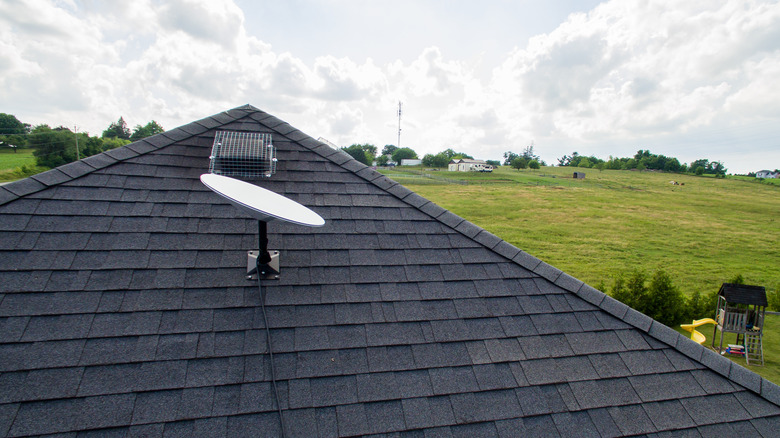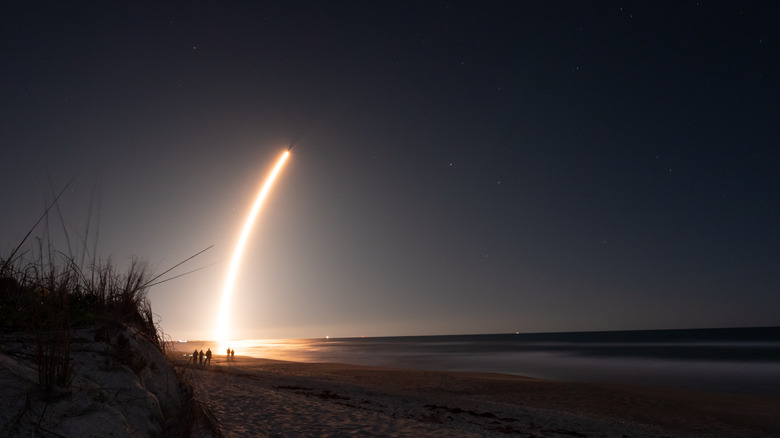The Truth About The Thousands Of Satellites Elon Musk Is Launching Into Orbit
According to the U.N., almost half of the world's population does not have internet access. An even lower percentage of people in developing countries have no access to the web in an age where the most developed countries take internet connectivity for granted. Starlink's objective is to solve that problem by bypassing traditional internet infrastructure like fiber optic cables that are yet to cover remote locations, especially in developing countries.
When most of the Starlink satellites have been deployed, they will blanket the planet to provide internet from just about anywhere –- from the Sahara Desert, the Congo rainforest, Amazon jungle, and Antarctic regions to tropical islands in the middle of nowhere. Beta tests have been run and the whole system is well on its way to consumer readiness — but they're not quite there yet.
Since Starlink satellites receive and send signals from space, they're also difficult to shut down. When Elon Musk answered Ukraine's call for help by activating Starlink internet services to help fight the Russian invasion, both the strengths and the weaknesses of the system were put in full view. While internet signals sent from space are extremely difficult for enemy forces (or government entities) to block, Starlink also has some rather strict guidelines for hardware placement and movement.
Starlink satellites are in low earth orbit
In 2018, Starlink made history by launching its first prototype satellites into space. The private company, which is a division of Space X, followed up by deploying more satellites into orbit every year — usually in a span of a few months. To put it into perspective, it launched over 2,900 satellites into orbit between 2018 and 2022.
But Starlink is not done yet –- it recently got the FCC to greenlight its plan to deploy over 40,000 satellites over the next decade. That's a big number, and if it achieves its target, Starlink could have more satellites in space than any other entity here on Earth. The real reason why SpaceX is sending so many Starlink satellites into space is to offer internet speeds that could compete with the fastest alternatives.
According to Bloomberg, Starlink satellites need to be as low as possible to the ground to reduce latency. Unlike traditional satellites that orbit the earth up to 22,223 miles above the surface, Starlink satellites are positioned in low earth orbit (LEO) which is between 311 miles and 1,243 miles above the ground. Low earth orbit satellites travel faster than medium earth orbit satellites, circling the planet in about two hours or less. This means they cover a smaller area while moving super-fast in orbit, and if you want to blanket the entire planet, you need thousands of LEO satellites to pull it off.
They could collide with other satellites in orbit
Each time Starlink launches more satellites into orbit, collisions with other objects in space become more likely. "The number of encounters picked up by the Socrates database has more than doubled and now we are in a situation where Starlink accounts for half of all encounters," said Hugh Lewis, professor and head of the Astronautic Research Group at the University of Southampton (via Space.com).
Despite the probability of a collision, there have been only three recorded incidents (not involving Starlink) where satellites collided in orbit. This is because all satellite pathways are monitored by the United States Space Command, and close approach reports are submitted through Space Track to avert a collision before it happens. Also, Starlink satellites are designed with autonomous collision avoidance systems to prevent potential collisions. SpaceX technology hasn't yet figured out a way to avoid launched Starlink satellites from getting destroyed in geomagnetic storms, but it assures the public that debris won't be a problem.
They could interfere with astronomy
Astronomers also complained that Starlink satellites (among others) could interfere with telescope feedback. "The surfaces of these satellites are often made of highly reflective metal, and reflections from the Sun in the hours after sunset and before sunrise make them appear as slow-moving dots in the night sky", the International Astronomical Union (IAU) said in a statement in June 2019. "Aggregate radio signals emitted from the satellite constellations can still threaten astronomical observations at radio wavelengths," said the IAU.
Starlink responded by designing new satellites with non-reflective coating and visors so they don't interfere with astronomy telescopes (via CNET). However, Science reports that SpaceX is yet to figure out a solution for the radio signal interference.
We expect SpaceX to launch thousands of satellites over the next decade to improve its internet services in remote locations. But Starlink won't be the only sheriff in space, as Amazon is also planning to deploy thousands of satellites into orbit.



